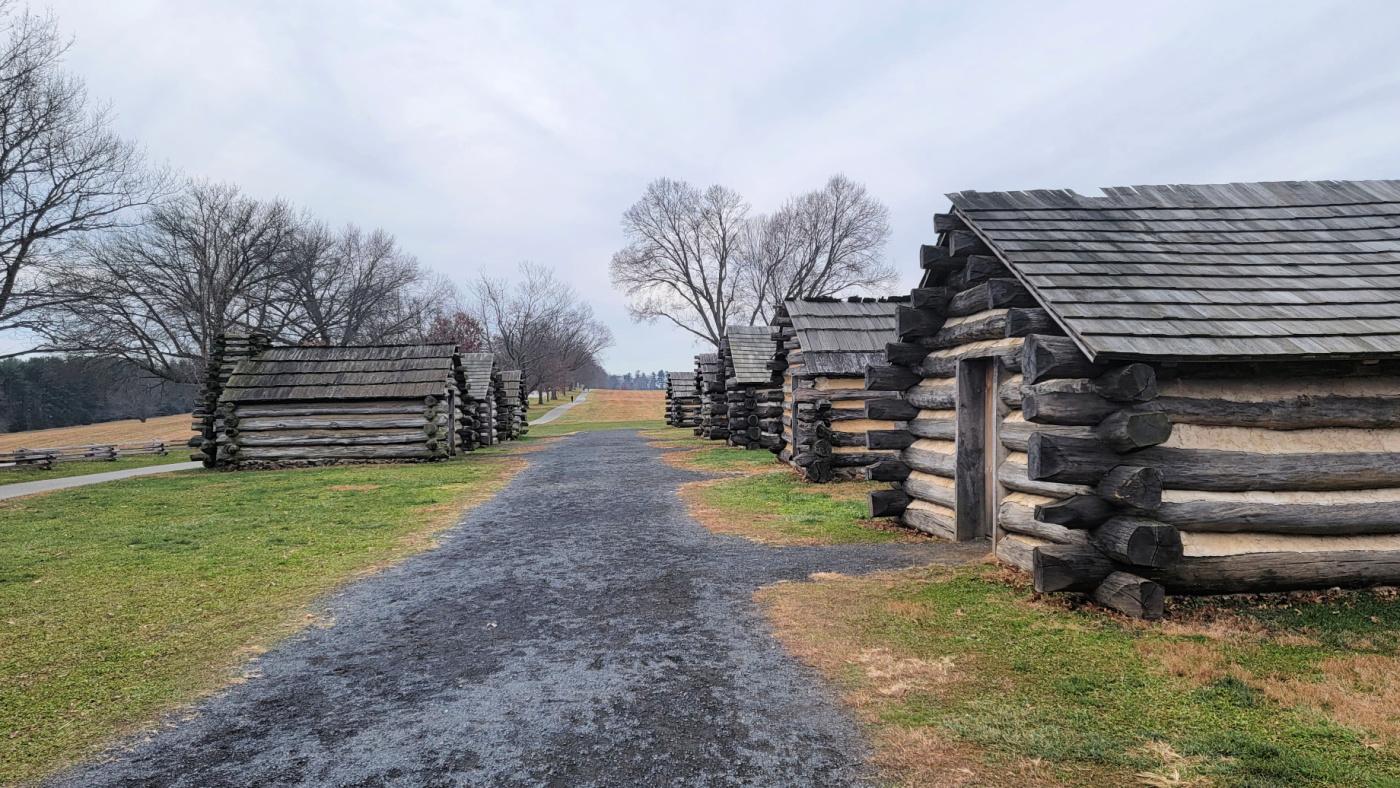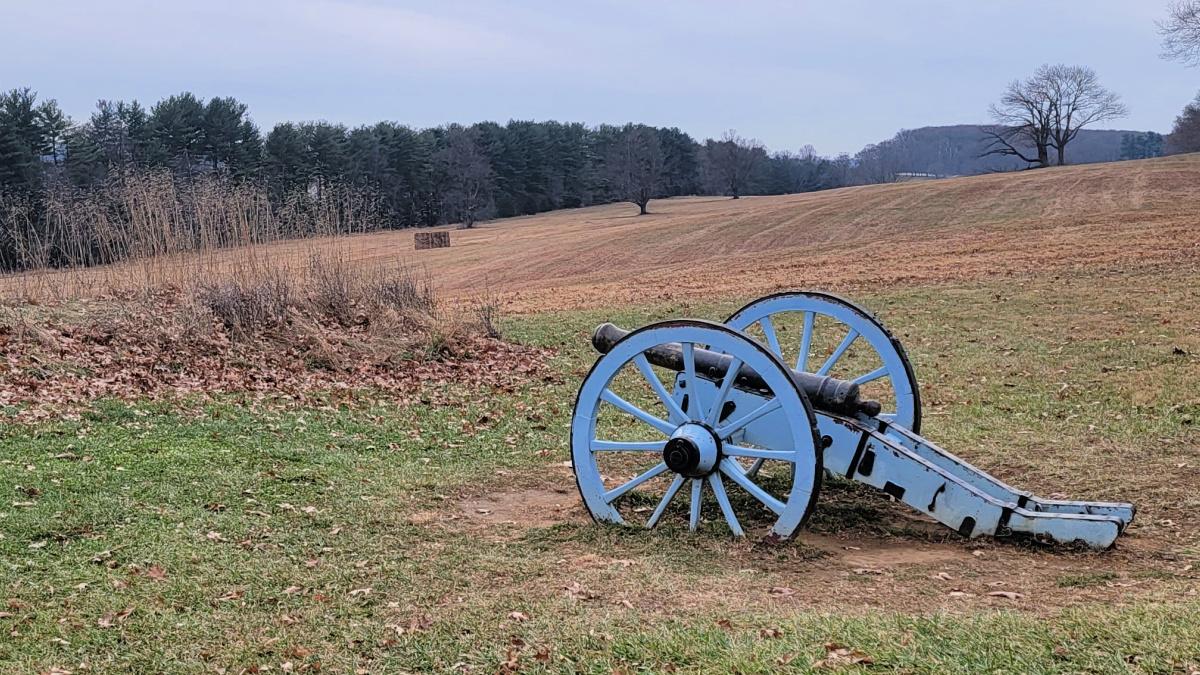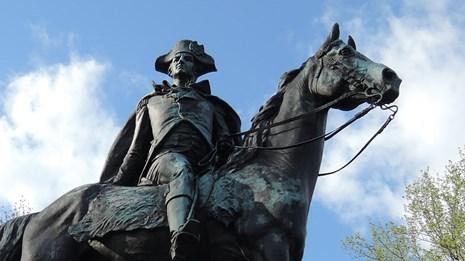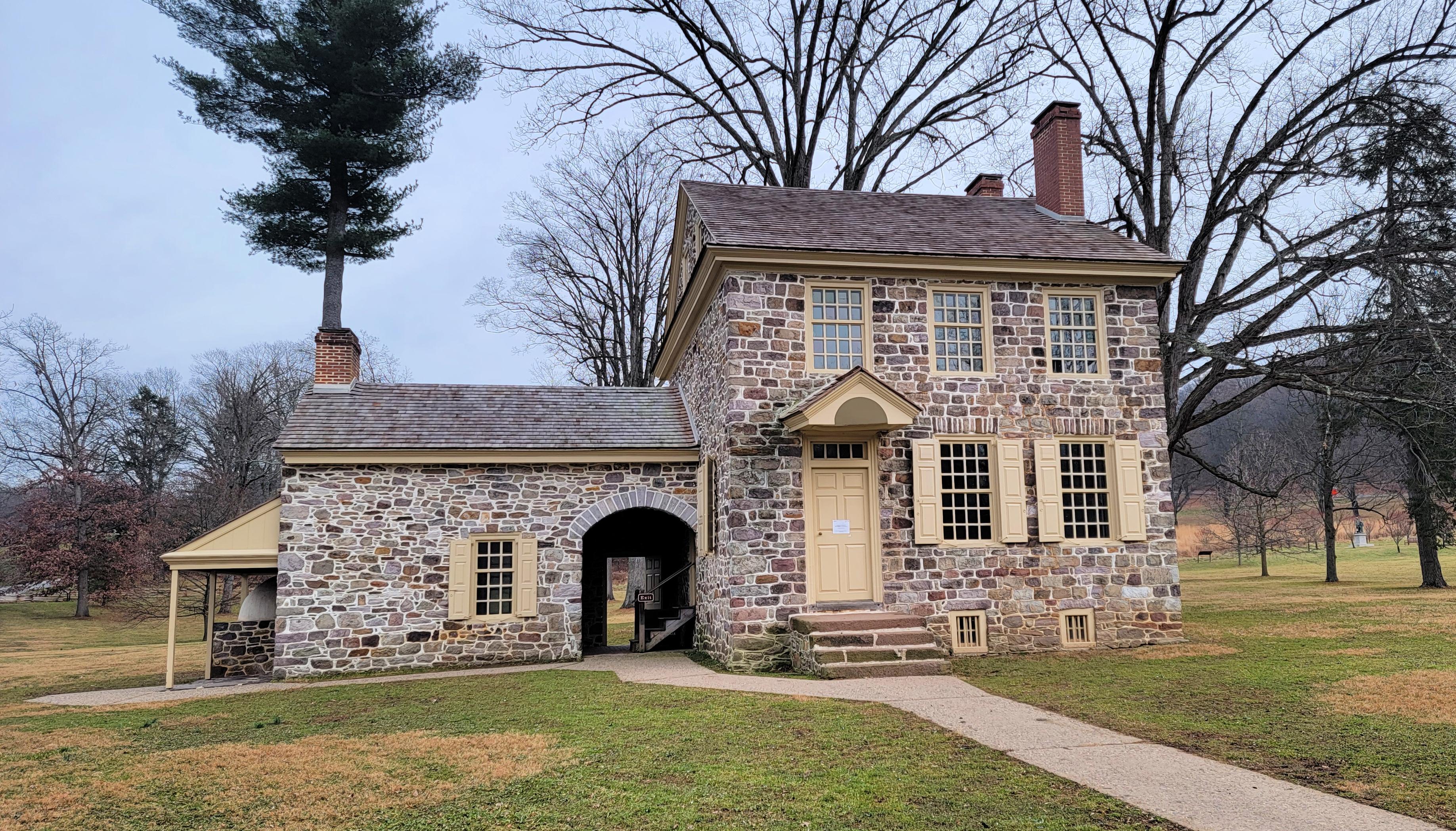
Reconstructed soldiers' huts at Valley Forge. / Kim O'Connell
A Winter Encampment
A cold day makes Valley Forge National Historical Park a particularly haunting and powerful place to visit.
By Kim O’Connell
It was a landscape of contrasts—dormant grass, yellow as straw, bright red winterberries clustered on twiggy bushes, a ring of gray, barren trees in the distance. From certain vantage points, the silence was so eerie, and the vistas so stark, that it was easy to reel the mind backwards to the winter of 1777-78, when the Continental Army made its camp here among the hills above the Schuylkill River.
This windswept landscape, of course, is Valley Forge National Historical Park, about a 40-minute drive northwest of Philadelphia. During my preteen daughter’s winter break from school, she and I traveled from our home in northern Virginia outside Washington, D.C., to Valley Forge for some fresh air and respite, a chance to reconnect with each other and with some Revolutionary history. Although George Washington’s outsized legacy is hard to ignore where we live—with the Washington Monument just across the Potomac and Mount Vernon just to the south—we were keen to learn more about Washington as the army’s commander-in-chief during this trying period and, even more so, about the men and women he led.
By late 1777, the American Revolution had been under way for well over two years. Site of the First Continental Congress and the initial meeting site for the Second Continental Congress, Philadelphia was a significant military prize—a centrally located port city that sat at the confluence of the Schuylkill and Delaware rivers.

A cannon stands forever at the ready at Valley Forge. / Kim O'Connell
With the British controlling the city in the fall of ‘77, Washington chose the plateau at Valley Forge for a winter encampment, encouraged that the terrain would deter British attack and that access to the river would help with transporting supplies. On December 19, 12,000 soldiers, as well as about 400 women and children, began to build the encampment that the army would call home for the next six months.
Conditions at the camp were famously brutal. After establishing the camp, Washington sent an urgent letter to most of the state legislatures, asking for assistance in the form of more men and supplies. “It is not easy to give you a just and accurate idea of the sufferings of the Army,” he wrote in a letter to the New Hampshire delegation. “Were they to be minutely detailed, your feelings would be wounded, and the relation would probably be not received without a degree of doubt & discredit. We had in Camp, on the 23rd…not less than 2898 men unfit for duty, by reason of their being barefoot and otherwise naked. Besides this number, sufficiently distressing of itself, there are many Others detained in Hospitals and crowded in Farmers Houses for the same causes.”
Having been protected as a state park since 1893, the national historical park was created in 1976 as a gift from Pennsylvania at the height of the nation’s bicentennial fervor. The park encompasses about 3,500 acres, and a 10-mile park road encircles the most notable spots, including soldiers’ huts, statues and historical markers, redoubts, trenches, and other defenses, and perhaps most significantly, Washington’s headquarters. The park offers a self-guided tour and a free audio accompaniment accessible via cell phone (courtesy of Friends of Valley Forge), which we chose to do (the park also sells CDs with an hour-long audio tour in the park gift shop). Ample trails crisscross the park, which meant that we’d also have opportunities to hop out and stretch our legs.
Our first stop was the site of Muhlenberg’s Brigade, one of the most popular areas of the park. Here sit two rows of reconstructed soldiers’ huts aligned on a gravel “company street.” During the war, hundreds of these 14’ by 16’ log cabins formed a veritable city at Valley Forge, a hive of sleeping, cooking, eating, drilling, and commiserating. Nearby sits a reconstructed redoubt, ringed with a fraise of sharpened stakes designed to deter the enemy, that is oriented towards Philadelphia. Often, the park hosts living history demonstrations here, but on the cold, cloudy winter day we visited, we were alone.
Although my daughter made sure to take a couple selfies amid the log huts to text her friends—practically a preteen ritual—I also saw the light switch on in her mind as we talked about what it must have been like to live here for months on end. We’d been complaining about the raw, cloudy day, grateful to jump back in the car and blast the heat after taking a walk around the huts and the redoubt. My daughter was astonished to see that the huts were smaller than our family room, and that soldiers slept there in bunks stacked three high to the ceiling, 12 to a hut.
Soldiers at Valley Forge suffered from malnutrition, lack of clothing and shoes, and disease. “I am ashamed to say it,” wrote Army surgeon Albigence Waldo in a despairing letter from Valley Forge in December 1777, “but I am tempted to steal Fowls if I could find them, or even a whole Hog, for I feel as if I could eat one. But the Impoverish'd Country about us, affords but little matter to employ a Thief, or keep a Clever Fellow in good humour….It is not in the power of Philosophy...to convince a man he may be happy and Contented if he will, with a Hungry Belly. Give me Food, Cloaths, Wife and Children, kind Heaven! and I'll be as contented as my Nature will permit me to be.”

A statue of General Anthony Wayne, a native Pennsylvanian, stands prominently at Valley Forge. / NPS
Stopping at the National Memorial Arch and a statue of Pennsylvania’s own General Anthony Wayne allowed the audio tour to teach us about the role of Pennsylvania regiments at Valley Forge and of women in the Revolution, a story that I was particularly grateful to the National Park Service for including. Women’s roles on battlefields and in camp were not something I heard often about as a young history buff, and I was glad that my daughter was having a different experience at Valley Forge. We learned about the wives, sisters, and mothers who followed the men into the camp and did various tasks to keep soldiers fed, their clothes clean, and their spirits lifted. Many served as nurses, and some even fought as undercover soldiers. Women were even listed on muster rolls as being owed half rations or half pay for their service.
“Many times the people who work in the background of a situation are the unsung heroes of the conflict,” the tour narrated. “These unsung heroes of the Revolution are actually heroines, women who endured all the hardships alongside the soldiers.”
Unsung heroes were on my mind, too, as we drove through the undulating landscape to the area of Washington’s headquarters, situated above the Schuylkill River. During the encampment, Washington chose to stay with his soldiers versus travel home to Mount Vernon, renting a two-story stone mill house from a relative of Isaac Potts, who operated the family grist mill. Here, Washington conducted army business on the first floor, with huts for his guards just a short distance away. His wife Martha joined him in the milder, later months of the encampment.
The park ranger at the visitor center, correctly gauging my daughter’s keen sense of pop culture, made sure to mention that Alexander Hamilton had been a constant advisor to Washington at Valley Forge, working at his headquarters. As a fan of the Hamilton musical, my daughter seemed noticeably excited to know that the real Hamilton had walked in the very place we walked. Although the house was closed during our visit, we were able to pass through a covered walkway, which gave us a picturesque framed view of the soldier huts in the distance. Historic preservation at work, I thought.
Standing at Washington’s headquarters gave us a chance to consider the lives of Black Americans in the Revolution, including people Washington enslaved. The park includes a monument to Black patriot soldiers, who numbered in the hundreds at Valley Forge, out of the estimated 5,000 Black soldiers who fought for the American cause in the Revolution. Numerous enslaved people were also at Valley Forge, and I appreciated that the audio tour introduced us to one of them, Hannah Mason Till.

General George Washington's headquarters at Valley Forge, a mid-18th century house belonging to the family of local mill owner Isaac Potts. / Kim O'Connell
Till was an enslaved cook who was able to purchase her freedom during the Revolution. She was eight months pregnant during that Valley Forge winter, giving birth to her fourth of an eventual seven children in January 1778. Here the audio tour makes a welcome switch from a standard third-person narration to a first-person narrative, told from Till’s perspective by longtime Valley Forge interpretive ranger Ajena C. Rogers (now the supervisory park ranger at Maggie L. Walker National Historic Site).
According to a video on the park website, Rogers did extensive research on Till that informed her interpretive demonstrations about her. “I, a slave, know how it is to dream and strive and hope for freedom,” Rogers says, as Till, on the audio tour, before quoting Scripture: “Hope deferred makes the heart sick, but when the desire comes it is the tree of life.”
With the coming 250th anniversary of the American Revolution, beginning in 2025, Valley Forge is capturing history while telling broader stories that are relevant to today and the future. As the sky darkened and the air grew colder, we got in the car to head back to Virginia, and we imagined the campfires of Valley Forge, keeping the hopes and ideals of a young nation burning. As my daughter learns with each passing day, those ideals are still being tested, and that’s worth thinking about, too.

Comments
Great article, great park, and an important story well preserved. Well worth the visit!!